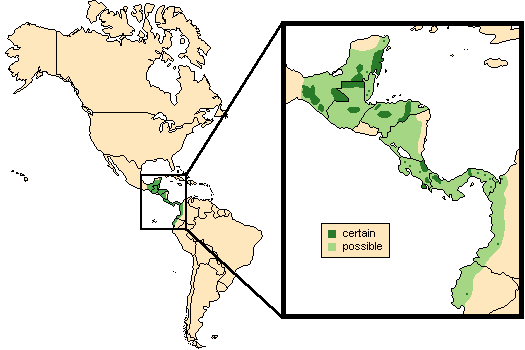![]() Return
to Perissodactyla
Return
to Perissodactyla
Classification
|
 Tapirus
bairdii
Tapirus
bairdii
Baird's tapir, Central American tapir
![]()
Taxonomy
 |
 |
 |
Click on the pictures above for a larger view of the
photographs
|
||
General Characteristics
Body Length: 198-202 cm / 6.5-6.7 ft.
Shoulder Height: up to 120 cm / 4 ft.
Tail Length: 7-13 cm / 3-5 in.
Weight: 240-400 kg / 525-880 lb.The thick hide is covered with a short, bristly-haired, dark brown coat. Young animals have a reddish-brown coat brightly marked with white streaks and spots. At higher elevations, animals grow thicker coats as protection from the cold. The throat and cheeks are a light grayish-yellow, and there is usually a dark spot situated below and behind the eye. The edges of the rounded ears are white. The most noticable feature of the tapir is its prehensile nose, which looks and functions like a shortened version of an elephant's trunk. Baird's tapir is the largest and heaviest of the New World tapir species, with a barrel-shaped body and stocky legs. There is no crest on the neck.
Ontogeny and Reproduction
Gestation Period: 390-400 days.
Young per Birth: 1, rarely 2.
Weaning: At about 1 year.
Sexual Maturity: At 1.5-2 years.
Life span: Over 30 years.
Ecology and Behavior
Baird's tapir can be either diurnal or nocturnal, although in areas where it is hunted most activity occurs during the night. They are very agile and can negotiate steep slopes with ease. The tell-tale sign of Baird's tapir are repeatedly used paths through the jungle, which the tapirs mark regularly. These tapirs usually stay close to water, and on hot days have been observed submerged with only their heads above the surface. They communicate with shrill whistles.Family group: Solitary.
Diet: Plant matter, including fallen fruit.
Main Predators: Mountain lion, jaguar, humans.
Distribution
Dense tropical jungles up to an altitude of 3,350 m / 10,700 ft in Central America.

Range Map (Redrawn from Matola et al., 1997)
Conservation Status
Baird's tapir is classified as a vulnerable species by the IUCN (1996).
Remarks
Tapirus is a Latinized corruption of tapyra - the Tupi name for the tapir (the Tupis are an aboriginal tribe from the Amazon). W. M. Baird was an American naturalist who made an expedition to Mexico in 1843. Although Baird is credited with its 'discovery', this tapir was first documented by W. T. White, another American naturalist.
Literature Cited
Eisenberg, J. F., C. P. Groves, and K. MacKinnon. 1990. Tapirs. In Grzimek's Encyclopedia of Mammals. Edited by S. P. Parker. New York: McGraw-Hill. Volume 4, pp. 597-608.Matola, S., A. D. Cuarón, and H. Rubio-Torgler. 1997. Status and action plan of Baird's tapir (Tapirus bairdi). In Tapirs - Status Survey and Conservation Action Plan. IUCN/SSC Tapir Specialist Group. Compiled by D. M. Brooks, R. E. Bodmer, and S. Matola. IUCN, Gland, Switzerland and Cambridge, UK. Available online at http://www.tapirback.com/tapirgal/iucn-ssc/tsg/action97/default.htm
Wilson, D. E., and D. M. Reeder [editors]. 1993. Mammal Species of the World (Second Edition). Washington: Smithsonian Institution Press. Available online at http://nmnhwww.si.edu/msw/
Return to Perissodactyla

![]()
© Brent Huffman, www.ultimateungulate.com |
|
|